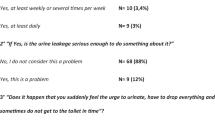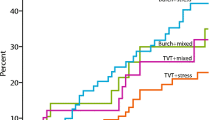Abstract
Purpose
The cure rate of tension-free vaginal tape (TVT) appeared to decrease overtime, with an associated increased in the stress urinary incontinence (SUI) recurrence rate. We evaluated the long-term durability and functional outcomes of TVT and identified the risk factors that may affect recurrence.
Methods
Eighty-eight patients, who were cured of SUI 6 months after undergoing TVT, were followed-up for at least 12 years. At post-operative, the patients were evaluated with a Severity Index for Urinary Incontinence questions regarding cure, patient’s satisfaction, goal achievement, 3-day voiding diary with urinary urgency scale, uroflowmetry, and complications.
Results
Cure rates decreased from 96.6 % at 1-year post-surgery to 83.0 % at 5 years and that the cure rates between 5 and 12 year were similar (83.0 vs. 79.6 %). Valsalva leak point pressure (VLPP) < 60 H2O was the only independent factor that predicted recurrence (p = 0.011; hazard radio 5.31). At last follow-up, 39.2 and 70.0 % of patients were free of urgency and urgency incontinence, respectively; and de novo urgency and urgency incontinence developed in 40.5 and 17.2 % of these patients, respectively. Age was the only factor that predicted freedom from overactive bladder (OAB) symptom. There was a significant reduction in the maximal flow rate from 23.3 ± 9.0 ml/s pre-operation to 18.8 ± 6.7 ml/s at 12 years post-operation.
Conclusions
TVT is an effective long-term treatment for SUI, although the cure rate may decrease with time. A low VLPP was predictive of SUI recurrence, and patients showing no OAB symptoms tended to be younger.


Similar content being viewed by others
References
Coyne KS, Kvasz M, Ireland AM, Milsom I, Kopp ZS, Chapple CR (2012) Urinary incontinence and its relationship to mental health and health-related quality of life in men and women in Sweden, the United Kingdom, and the United States. Eur Urol 61(1):88–95
Hawkins K, Pernarelli J, Ozminkowski RJ, Bai M, Gaston SJ, Hommer C, Migliori RJ, Yeh CS (2011) The prevalence of urinary incontinence and its burden on the quality of life among older adults with medicare supplement insurance. Qual Life Res 20(5):723–732
Chong EC, Khan AA, Anger JT (2011) The financial burden of stress urinary incontinence among women in the United States. Curr Urol Rep 12(5):358–362
Ulmsten U, Henriksson L, Johnson P, Varhos G (1996) An ambulatory surgical procedure under local anesthesia for treatment of female urinary incontinence. Int Urogynecol J Pelvic Floor Dysfunct 7(2):81–85; discussion 85–86
Jelovsek JE, Barber MD, Karram MM, Walters MD, Paraiso MF (2008) Randomised trial of laparoscopic Burch colposuspension versus tension-free vaginal tape: long-term follow up. BJOG 115(2):219–225; discussion 225
Novara G, Ficarra V, Boscolo-Berto R, Secco S, Cavalleri S, Artibani W (2007) Tension-free midurethral slings in the treatment of female stress urinary incontinence: a systematic review and meta-analysis of randomized controlled trials of effectiveness. Eur Urol 52(3):663–678
Novara G, Artibani W, Barber MD, Chapple CR, Costantini E, Ficarra V, Hilton P, Nilsson CG, Waltregny D (2010) Updated systematic review and meta-analysis of the comparative data on colposuspensions, pubovaginal slings, and midurethral tapes in the surgical treatment of female stress urinary incontinence. Eur Urol 58(2):218–238
Ogah J, Cody JD, Rogerson L (2009) Minimally invasive synthetic suburethral sling operations for stress urinary incontinence in women. Cochrane Database Syst Rev 4:CD006375
Chaikin DC, Rosenthal J, Blaivas JG (1998) Pubovaginal fascial sling for all types of stress urinary incontinence: long-term analysis. J Urol 160(4):1312–1316
Kjolhede P (2005) Long-term efficacy of Burch colposuspension: a 14-year follow-up study. Acta Obstet Gynecol Scand 84(8):767–772
Denman MA, Gregory WT, Boyles SH, Smith V, Edwards SR, Clark AL (2008) Reoperation 10 years after surgically managed pelvic organ prolapse and urinary incontinence. Am J Obstet Gynecol 198(5):555 e551–555 e555
Fialkow M, Symons RG, Flum D (2008) Reoperation for urinary incontinence. Am J Obstet Gynecol 199(5):546 e541–546 e548
Doo CK, Hong B, Chung BJ, Kim JY, Jung HC, Lee KS, Choo MS (2006) Five-year outcomes of the tension-free vaginal tape procedure for treatment of female stress urinary incontinence. Eur Urol 50(2):333–338
Klutke C, Siegel S, Carlin B, Paszkiewicz E, Kirkemo A, Klutke J (2001) Urinary retention after tension-free vaginal tape procedure: incidence and treatment. Urology 58(5):697–701
Partoll LM (2002) Efficacy of tension-free vaginal tape with other pelvic reconstructive surgery. Am J Obstet Gynecol 186(6):1292–1295; discussion 1295–1298
Daneshgari F, Kong W, Swartz M (2008) Complications of mid urethral slings: important outcomes for future clinical trials. J Urol 180(5):1890–1897
Abrams P, Cardozo L, Fall M, Griffiths D, Rosier P, Ulmsten U, Van Kerrebroeck P, Victor A, Wein A, Standardisation Sub-Committee of the International Continence S (2003) The standardisation of terminology in lower urinary tract function: report from the standardisation sub-committee of the International Continence Society. Urology 61(1):37–49
Hanley J, Capewell A, Hagen S (2001) Validity study of the severity index, a simple measure of urinary incontinence in women. BMJ (Clinical Research ed) 322(7294):1096–1097
Coyne KS, Margolis MK, Hsieh R, Vats V, Chapple CR (2011) Validation of the urinary sensation scale (USS). Neurourol Urodyn 30(3):360–365
Nilsson CG, Palva K, Rezapour M, Falconer C (2008) Eleven years prospective follow-up of the tension-free vaginal tape procedure for treatment of stress urinary incontinence. Int Urogynecol J Pelvic Floor Dysfunct 19(8):1043–1047
Olsson I, Abrahamsson AK, Kroon UB (2010) Long-term efficacy of the tension-free vaginal tape procedure for the treatment of urinary incontinence: a retrospective follow-up 11.5 years post-operatively. Int Urogynecol J 21(6):679–683
Rogo-Gupta L, Baxter ZC, Le NB, Raz S, Rodriguez LV (2012) Long-term durability of the distal urethral polypropylene sling for the treatment of stress urinary incontinence: minimum 11-year followup. J Urol 188(5):1822–1827
Paick JS, Ku JH, Shin JW, Son H, Oh SJ, Kim SW (2004) Tension-free vaginal tape procedure for urinary incontinence with low Valsalva leak point pressure. J Urol 172(4 Pt 1):1370–1373
McGuire EJ, Lytton B, Pepe V, Kohorn EI (1976) Stress urinary incontinence. Obstet Gynecol 47(3):255–264
Clemons JL, LaSala CA (2007) The tension-free vaginal tape in women with a non-hypermobile urethra and low maximum urethral closure pressure. Int Urogynecol J Pelvic Floor Dysfunct 18(7):727–732
Aigmueller T, Trutnovsky G, Tamussino K, Kargl J, Wittmann A, Surtov M, Kern P, Frudinger A, Riss P, Bjelic-Radisic V (2011) Ten-year follow-up after the tension-free vaginal tape procedure. Am J Obstet Gynecol 205(5):496 e491–496 e495
Chene G, Amblard J, Tardieu AS, Escalona JR, Viallon A, Fatton B, Jacquetin B (2007) Long-term results of tension-free vaginal tape (TVT) for the treatment of female urinary stress incontinence. Eur J Obstet Gynecol Reprod Biol 134(1):87–94
Debodinance P, Delporte P, Engrand JB, Boulogne M (2002) Tension-free vaginal tape (TVT) in the treatment of urinary stress incontinence: 3 years experience involving 256 operations. Eur J Obstet Gynecol Reprod Biol 105(1):49–58
Kenton K, Lowenstein L, Simmons J, Brubaker L (2007) Aging and overactive bladder may be associated with loss of urethral sensation in women. Neurourol Urodyn 26(7):981–984
Han JY, Song C, Park J, Jung HC, Lee KS, Choo MS (2010) A long-term study of the effects of the tension-free vaginal tape procedure for female stress urinary incontinence on voiding, storage, and patient satisfaction: a post hoc analysis. Korean J Urol 51(1):40–44
Park S, Hong B, Lee KS, Choo MS (2005) Risk factors of voiding dysfunction and patient satisfaction after tension-free vaginal tape procedure. J Korean Med Sci 20(6):1006–1010
Lin LY, Sheu BC, Lin HH (2004) Sequential assessment of urodynamic findings before and after tension-free vaginal tape (TVT) operation for female genuine stress incontinence. Eur Urol 45(3):362–366; discussion 366
Lose G, Fantl JA, Victor A, Walter S, Wells TL, Wyman J, Mattiasson A (1998) Outcome measures for research in adult women with symptoms of lower urinary tract dysfunction. Neurourol Urodyn 17(3):255–262
Weber AM, Abrams P, Brubaker L, Cundiff G, Davis G, Dmochowski RR, Fischer J, Hull T, Nygaard I, Weidner AC (2001) The standardization of terminology for researchers in female pelvic floor disorders. Int Urogynecol J Pelvic Floor Dysfunct 12(3):178–186
Sandvik H, Espuna M, Hunskaar S (2006) Validity of the incontinence severity index: comparison with pad-weighing tests. Int Urogynecol J Pelvic Floor Dysfunct 17(5):520–524
Conflict of interest
On behalf of all authors, the corresponding author states that there is no conflict of interest.
Author information
Authors and Affiliations
Corresponding author
Appendix
Rights and permissions
About this article
Cite this article
Han, JY., Park, J. & Choo, MS. Long-term durability, functional outcomes, and factors associated with surgical failure of tension-free vaginal tape procedure. Int Urol Nephrol 46, 1921–1927 (2014). https://doi.org/10.1007/s11255-014-0759-1
Received:
Accepted:
Published:
Issue Date:
DOI: https://doi.org/10.1007/s11255-014-0759-1




